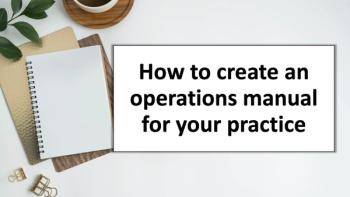
The Great Practice Makeover: Decision Time
For a small rural practice, it's time to get busy - or start laying off staff.
Solo family physician Lawrence Varner is facing an emergency decision: increase his productivity or slash his staff. If he simply maintains the status quo, Family Medicine of Farmville will die.
Varner and his wife, Linda, have dedicated their lives to their small community practice. Their dining room table is a permanent workstation where they labor on administrative tasks until 11:30 every night. But all that commitment is not paying off. Varner earned just $70,000 in 2005, and he is unlikely to make anywhere near that this year. He may not earn any profit at all, despite the fact that his revenues exceed the national benchmark by more than 40 percent. His wife hasn't been paid for the past two years. What's the problem?
One major issue is the huge cash payout the practice made last year for an EMR, which proved to be a blow to its financial stability. Varner thought the EMR would enable him to see more patients and get home earlier, but neither one of these scenarios have materialized. In fact, Varner's new system slowed him down. Now he and his wife spend their time at home experimenting with EMR templates rather than spending time with their children - even on weekends.
So Varner's ROI on his EMR is a big, fat zero thus far. Another problem - out-of-control staffing costs - might actually be easier for Varner to solve, lessening the impact of his ongoing EMR fiasco.
Overstaffing consequences
Varner has much better than average revenue. But his staffing costs are eating up all that extra income. The median staff-to-provider ratio for a family medicine practice is 3.57 full-time equivalent (FTE) employees for each FTE provider, according to data from the Medical Group Management Association. With only 1.5 providers (Varner and a part-time nurse practitioner), Family Medicine of Farmville should only require 5.4 support personnel. Currently, the practice bankrolls 9.2 staff members - nearly double what it needs. Varner pays for a whopping 2.66 staff hours per patient visit, compared to the national norm of 1.59. That adds up to an excessive amount of overhead.
When I met with this practice, it was on track to spend $296,802 on staffing costs this year alone. In terms of both the total amount he spends for staff and the percentage of net medical revenue the practice brings in, Varner's costs far exceed the national norm. He needs to either add providers to support all that infrastructure or slash staff - fast.
Overstaffing isn't just a financial nightmare. It's also a drain on the practice's time and emotional energy. Varner's employees are crowded into a small space; bickering and gossiping are rampant. Varner and his wife end up spending many evenings negotiating truces among staff members. They then find themselves fretting over the arguments themselves, all the time paying through the nose for this privilege.
The turning point: grow or shrink
Family Practice of Farmville cannot go on as it is. But what can Varner do to head off disaster? He has two options:
- Increase revenues. By boosting his own productivity and hiring additional nurse practitioners, Varner could theoretically bring in the extra money he needs to cover his staffing costs. Indeed, since his current nurse practitioner is soon leaving the practice, Varner has to determine his course of action now.
- Downsize staff. This would mean laying off staff and slashing overhead wherever possible, which would also slightly cut into the practice's productivity.
Given the business realities of Varner's practice, I recommend downsizing over increasing revenues. He would have to at least double the revenue he currently has coming in to cover his spiraling costs and still make a reasonable salary.
And Varner already has trouble finding qualified medical professionals in his small town, racking up $5,000 a year in recruiting costs. In his practice of six exam rooms, adding more NPs would be difficult in terms of providing them sufficient office space in which to work. Varner also spends a significant amount of time supervising his ancillary providers, spending hours a day reviewing their documentation and care plans. Furthermore, Varner has been practicing for more than 21 years, making him unlikely to suddenly start seeing more than his current level of 12 patients a day.
The Varners need their dining room table back. They need to have time for family. They need a calmer, more professional work environment. In short, they need a simpler practice - one with fewer headaches, not more.
Downsizing 101
Varner should forego replacing his departing NP. The practice is earning only $56,000 a year by employing her, partly because Varner spends an excessive amount of time overseeing her work. By freeing himself from this time-consuming task, Varner could easily see two more patients a day, which would offset that lost income by producing an additional $36,000 in net revenue.
That still translates into a $20,000 drop in annual revenues, but I'm not sure if the headache of managing an NP is worth the difference. The intangible (but no less real) reward of having less to worry about and, therefore, more time to boost one's own productivity counts for a lot too.
Varner also needs to reduce and restructure the rest of his staff. Retaining five to six employees should suffice for his practice's needs. Ideally, these employees should be one full-time nurse, one part-time nurse/lab tech, one receptionist with part-time help for answering phones and scanning documents, and one biller.
With this streamlined staff, the receptionist and part-time helper need only put in 70 hours combined per week, at the most. Varner's front-desk team should be fully trained to handle check-in and check-out procedures as well as collections tasks, and they should be well paid for their efforts. Also, Varner should guard against overstaffing his office on slow Friday afternoons.
Varner currently retains an office manager who is willing to manage the front desk instead as long as the job doesn't spiral out of control. Since Varner is currently doing all the administrative heavy lifting himself, she might as well make the transition to the front-desk spot.
In the short term, reducing staff is admittedly painful for everybody. It's tempting to delay letting people go to forestall this unpleasantness, but the Varners must act quickly and decisively to avoid a financial train wreck. I doubt they'll be able to break even in 2006 if they don't make drastic changes now. This restructuring must occur to keep Family Medicine of Farmville afloat now and to ensure its prosperity in the future.
Simplify processes
It's important to note the reason this practice ended up so overstaffed: Some tasks just weren't getting done. Adding an $11-an-hour staffer to solve the problem seemed smart at the time, but the Varners failed to consider the additional costs they incurred as they added each employee, including payroll services, payroll taxes, insurance, overtime, and the like. The costs of retaining employees go way beyond their wages. And as a staff grows in number, so does the amount of time and attention management must spend resolving their professional and personal issues. This can take away considerably from a physician's productivity.
Adding to his staff has certainly not solved Varner's second-biggest problem: effectively using the EMR for which he paid so dearly. Varner currently spends hours each day trying to get his new practice management software to function the way he wants it to. He's particularly having trouble setting the system up to process electronic remittances.
Since his EMR purchase includes computer support, Varner should contact his vendor immediately and give them 45 days to get his electronic remittance processes functioning properly. If his software contract provides any guarantees, Varner should insist that they be addressed and satisfied. If he finds it necessary, Varner should arrange a conference call for his vendor and core payers to eliminate the finger-pointing that is now taking place and orchestrate a solution.
Time-of-service payment processing is another area that needs attention. Currently, Varner's front-desk staff collect copays and the like, but they don't post the monies to a specified account. Collected payments typically remain at the front desk for a month before they are finally deposited. This occurs mostly because Varner's billers need that much time to retrospectively determine where these cash payments belong and to get them posted to the correct accounts. This not only curtails Varner's cash flow - it also greatly increases the risk of embezzlement.
Adding additional front-desk staff has not helped this; setting a firm policy will. The practice's front-desk personnel should batch payments, each matched to a charge ticket, at the end of every morning and afternoon clinic. The billing staff can then key in the payments efficiently and accurately.
With its newly pared down staff, Family Medicine of Farmville will also have to reduce the amount of care it provides over the phone. For example, Varner should require patients to come in for prescription renewals rather than offering them over the phone. A patient who needs a prescription renewed also likely needs to have his condition reassessed.
Finally, the practice should be reimbursed for the time it spends completing the forms patients typically bring into an office, such as sports physicals for school athletics. I suggest charging patients $15 per form.
Just relax
Varner is not unusual in believing bigger means better. He thought his struggling practice required more staff to address its problems and more providers to add revenue. In fact, Varner will be better off financially if he stays small and concentrates on efficient management.
The payoff won't be just economic. Even if Varner again nets only $70,000 this year, that cash will seem a lot sweeter if it puts food on a dining room table that can be used for actually dining, or if Varner can spend most evenings relaxing and recharging for the next day rather than panicking about a myriad of unresolved problems. For Varner, reviewing and then reorganizing his numbers will pave the way for his practice's ultimate success.
Elizabeth Woodcock, MBA, FACMPE, CPC, is a professional speaker and consultant specializing in practice management, with more than 13 years experience. She is a Fellow in the American College of Medical Practice Executives and a Certified Professional Coder. She can be reached at
This article originally appeared in the November/December 2006 issue of Physicians Practice.
Newsletter
Optimize your practice with the Physicians Practice newsletter, offering management pearls, leadership tips, and business strategies tailored for practice administrators and physicians of any specialty.














